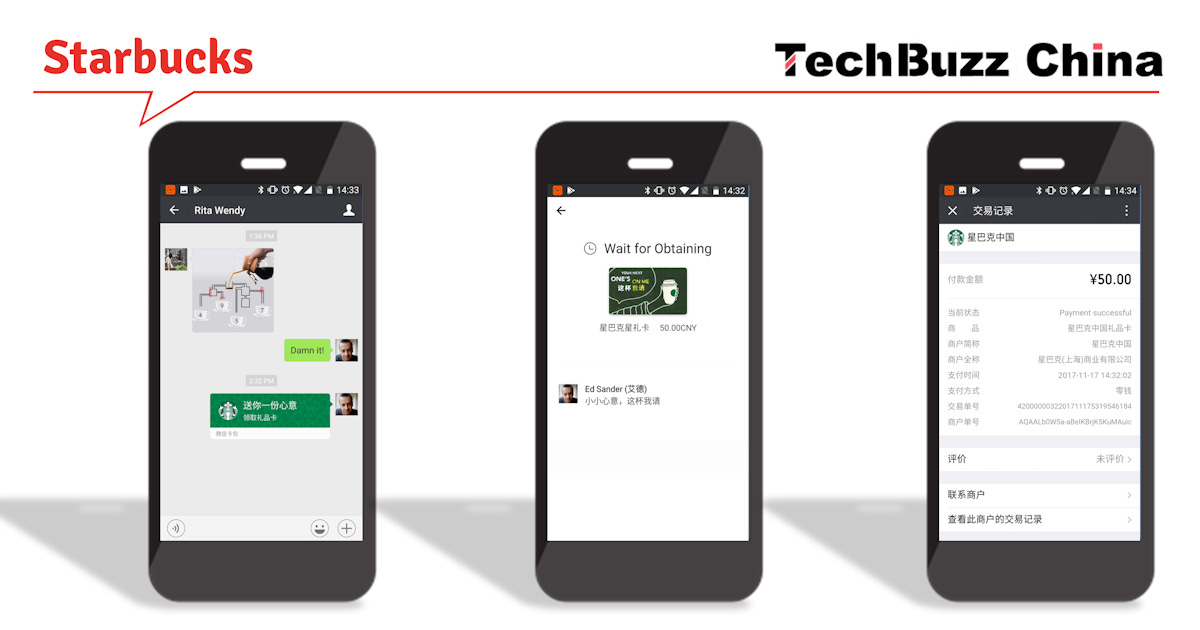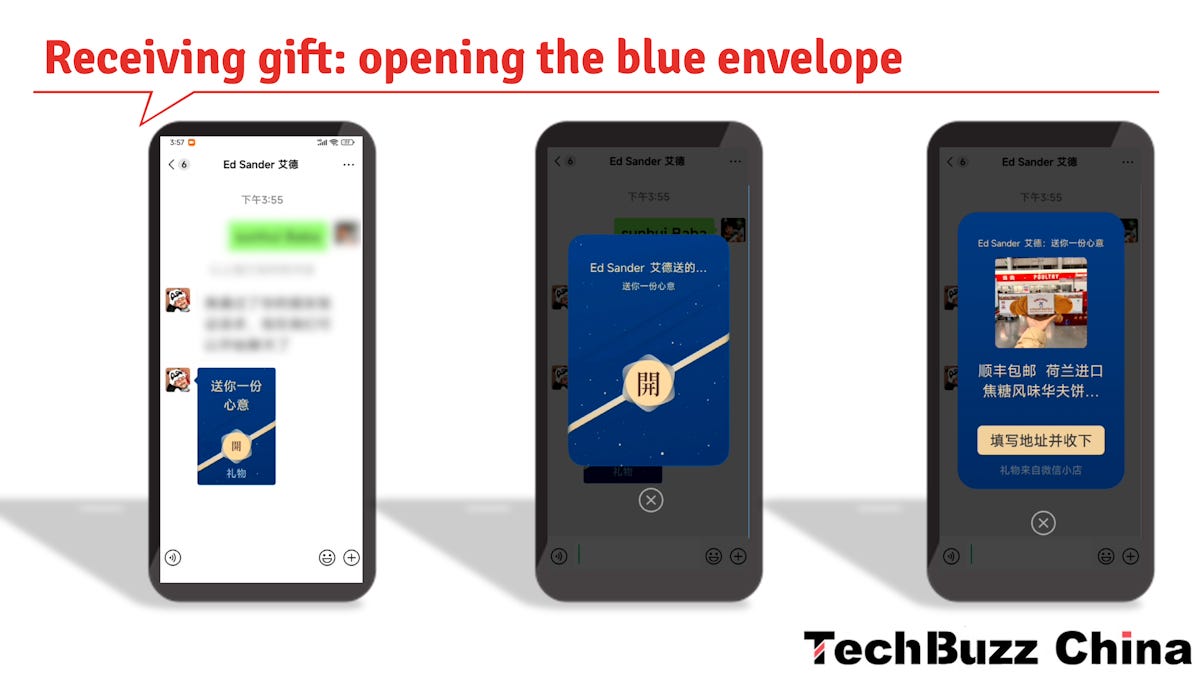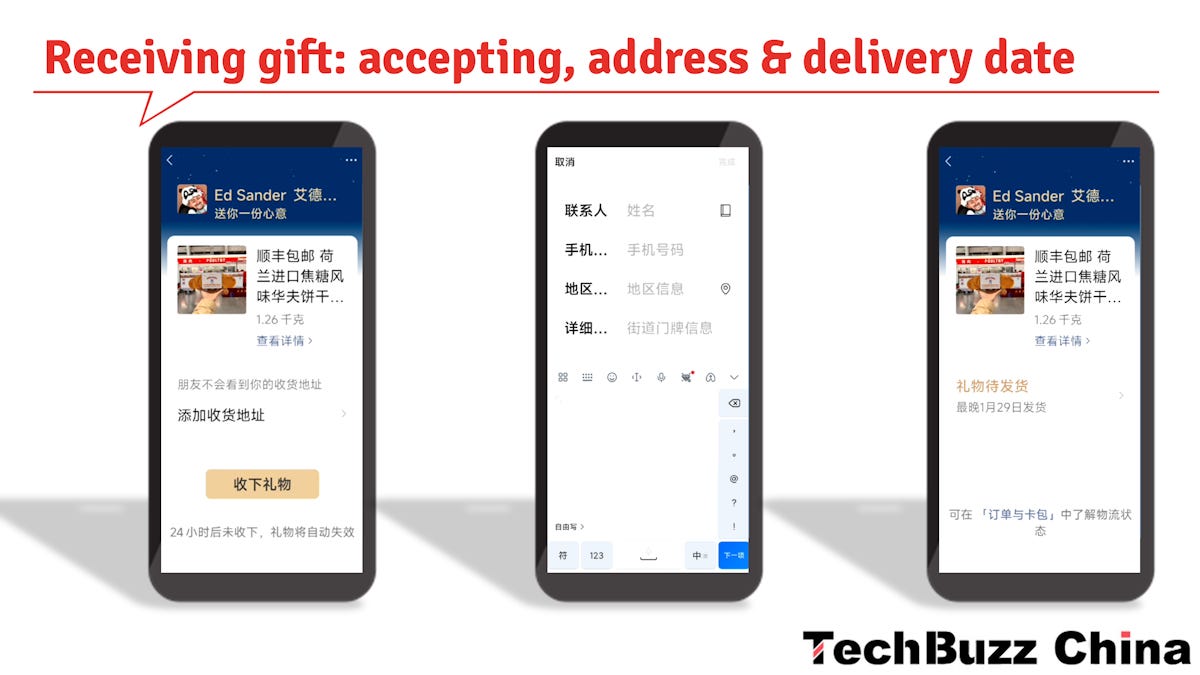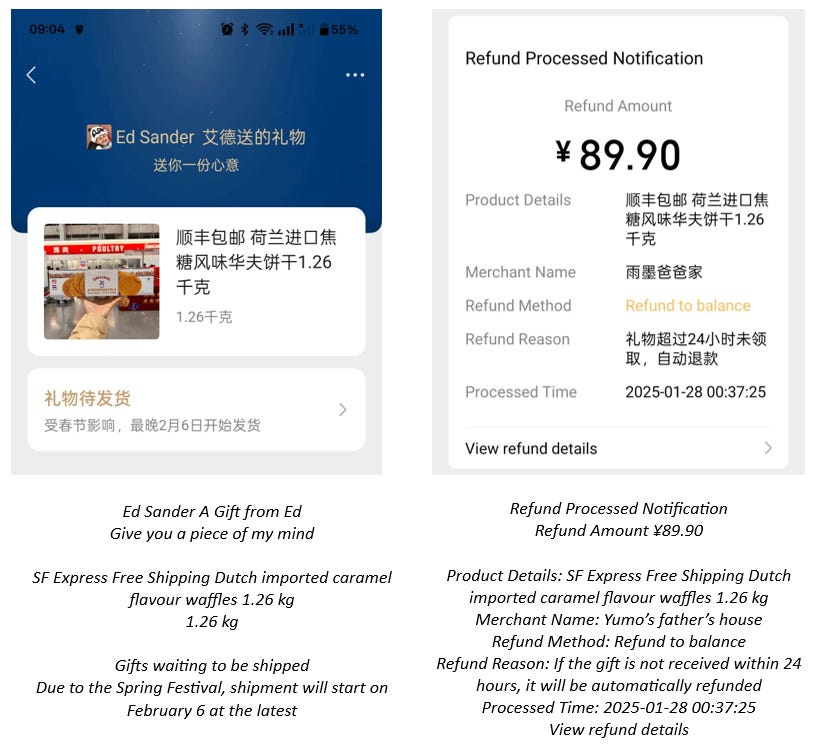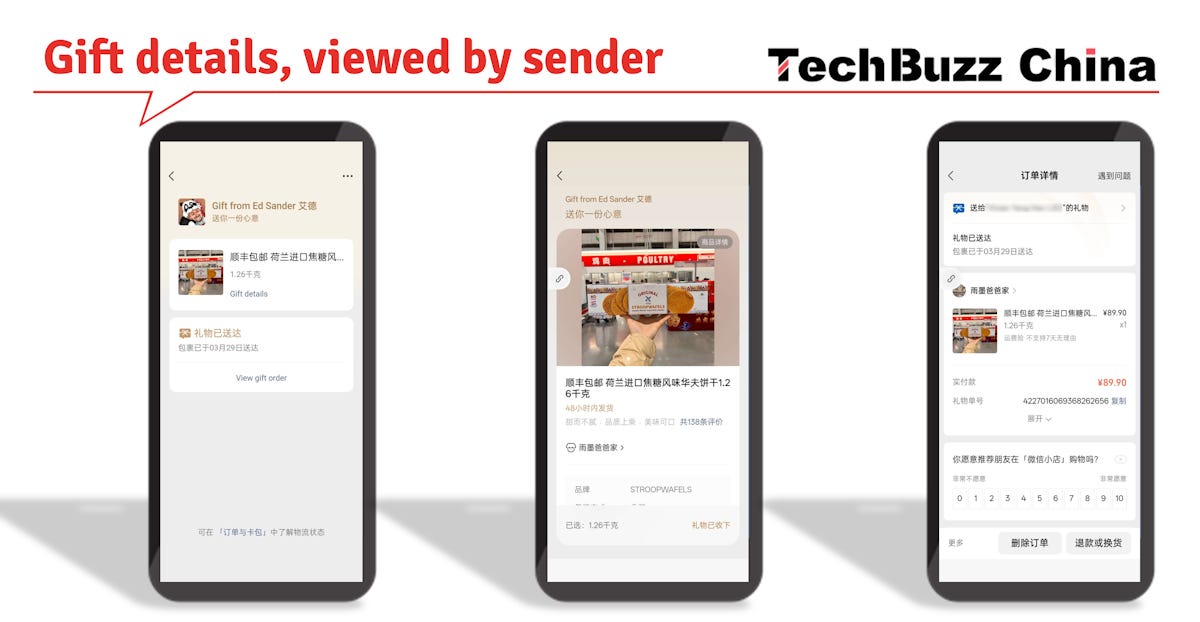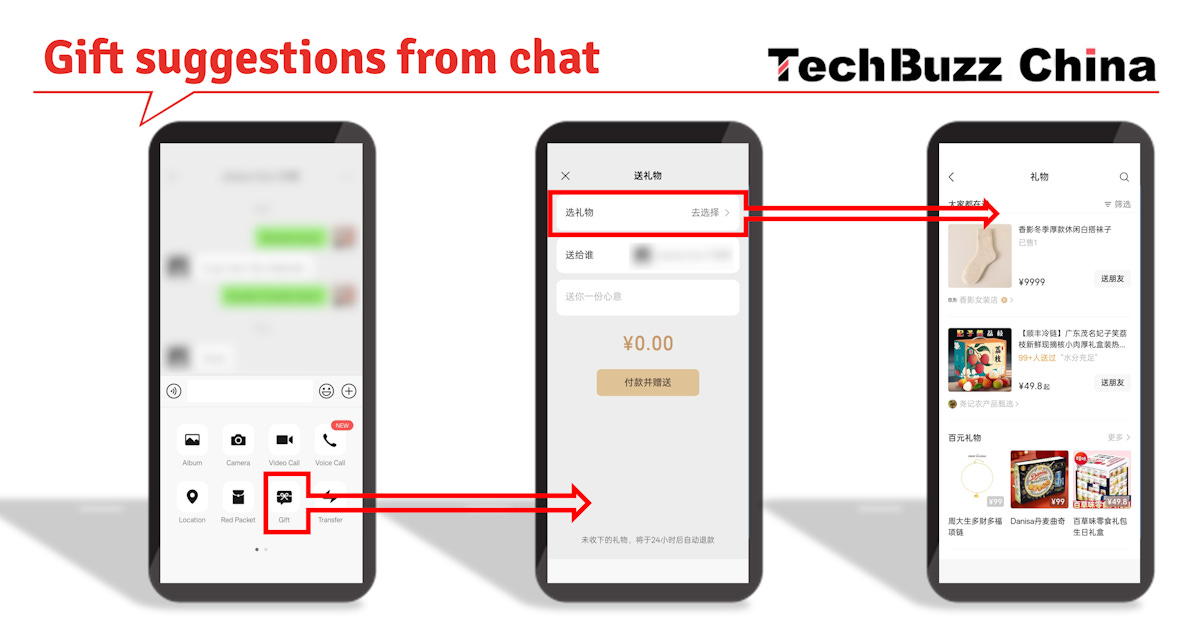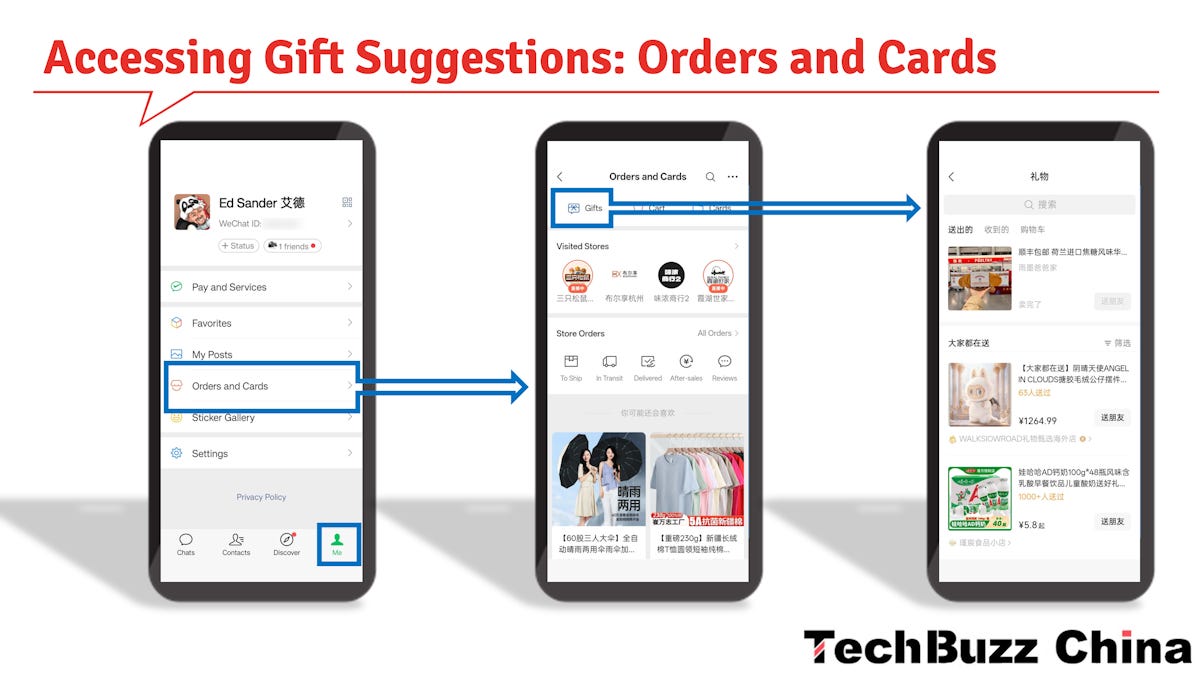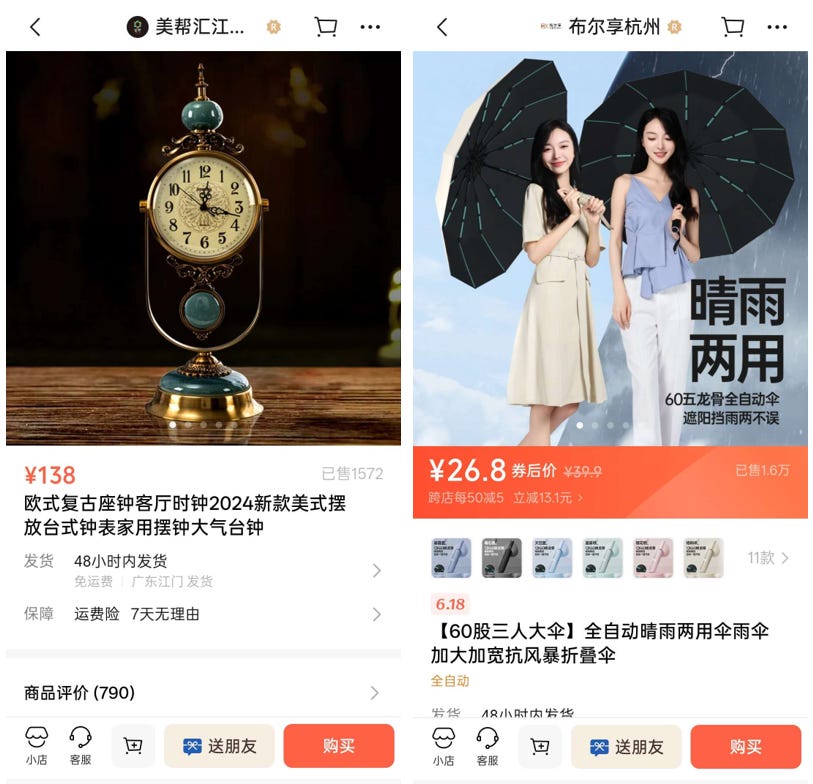Tencent’s e-Commerce Revival: Part 1 – WeChat’s Send Gifts Function
Did Tencent create another ‘Pearl Harbour’?
Contents
Things that caught our attention
Two and a Half Years at ByteDance US E-commerce. An account of a former R&D team manager’s experiences at TikTok Shop US.
Four Little Dragons That Go Overseas. Watch Ed Sander’s keynote at FashioTalks 2025 in Antwerp, Belgium.
China’s Coffee Wars. Luckin Coffee just opened its first US store in Manhattan. Time to learn more about how Luckin and Cotti Coffee started a coffee war in China and how Starbucks has responded. You can watch a slidecast of a presentation Ed Sander gave during a ChinaTechTrip retail study tour in October 2024.
The unconventional approach to market entry by Chinese companies, as seen by Rui Ma.
For a new Chinafile discussion, Rui weighs in on the question Is China About to Produce the Next ‘Sputnik Moment’?
A farewell letter from an Alibaba employee went viral in China.
Introduction
Tencent has never been a leading player in the e-commerce sector. Ten years ago, it sold all its e-commerce initiatives to JD.com (Jingdong), a partner and more experienced market leader.
Still, many things are sold on WeChat. On the one hand, there are WeChat (Mini) Stores of merchants. There are options to sell and livestream on WeChat Channels (although less aggressively positioned than on Douyin), and numerous mini-programs exist through which products and services are sold. However, WeChat has always been a facilitator, much more than a full-fledged e-commerce platform.
Now, there are signs Tencent is reconsidering monetisation through e-commerce. First, in mid-December, news broke that WeChat launched a new ‘Send Gifts’ functionality. It was enthusiastically received since it echoed WeChat’s digitisation of the ‘hong bao’ (red envelopes) during Spring Festival in 20214. Red envelopes are traditionally given as a gift (putting money in a red envelope makes it ‘lucky money’), and Tencent allowed WeChat users to send them digitally in WeChat chats. It was one of the success factors of WeChat Pay, and at the time, Jack Ma referred to WeChat’s sudden introduction of red envelopes as ‘a Pearl Harbour attack’ (on Alipay).
With the new Send Gift functionality, merchants can now also allow WeChat users to select products and send them as gifts to their contacts, rather than cash. Since gift-giving is very common in China, much is expected from this new functionality.
Another indicator that Tencent is reconsidering the role of e-commerce is that the topic was prominently featured in the annual WeChat Open Class held on January 9th. At the closed-door conference, plans for Send Gifts were discussed, as well as those for strengthening the link between various parts of its ecosystem, including mini-programs, WeChat Stores, and Service Accounts (a good idea, as the relationship between these has always been somewhat confusing).
Since it has been a while since we last wrote about WeChat and we have gained some insights into the initial performance of the gift-giving function, we decided to take another look at Tencent’s e-commerce initiatives within WeChat. In a two-part report, we will first examine the new Send Gift functionality. The explanation of how it functions is available for free to all subscribers. The section on the first results, challenges and expectations is accessible for paid subscribers. Subscribe to unlock the full report and support our in-depth research into key China tech trends.
Next month, we will revisit this topic with a broader examination of the current status of e-commerce within WeChat’s ecosystem, including WeChat Stores, mini-programs, and WeChat Channels.
Ed Sander, Tech Research Analyst
Sending gifts in WeChat
Unlike in some other cultures, where giving money as a gift can feel awkward and is often limited to special occasions, such as weddings, in China, it is perfectly acceptable to hand someone a red envelope with cash. Of course, this also happens mainly on special occasions, such as weddings, the Spring Festival, or when year-end bonuses are handed out. And it has also been common in cases of corruption …
When Tencent digitised the red envelopes in WeChat, sending money in a chat made making transfers much easier and faster than doing a bank transfer. In fact, users can also make regular money transfers in WeChat, but using a digital red envelope often makes the process more enjoyable. Tencent also gamified the functionality by allowing users to throw a digital red envelope in a chat group and randomly divide the contents among the first few people who opened it. ‘Grabbing red envelopes’ became a popular game.
Red envelopes containing a sum of money are also sent as a way of expressing gratitude after someone has done you a favour, and the exact amount is often symbolic. If the amount consisted of a lot of 8s, it was a symbol for wishing someone prosperity. With a series of 6s, you wished that things would go smoothly, and 9s symbolised the wish for a long-lasting relationship. The reason is that in Chinese, the pronunciations of 6, 8 and 9 sound like the words for smooth, prosperous and long.
The many ways in which numbers can be used as homophones for other Chinese words also created a way of sending messages through small amounts. For instance, 520 sounds a bit like ‘I love you’ in Chinese, so it is a message often sent on Valentine's Day or its Chinese equivalent, Qixi (the 7th day of the 7th lunar month).
All of these things contributed to making red envelopes a very popular way to send gifts to people in your WeChat network. However, before long, Tencent also developed alternative methods for sending small gifts. An example is the Starbucks Gift Card, introduced in 2017. From the WeChat Wallet, users could drop a gift card for a certain amount in a chat. The recipient could use it to buy products at Starbucks. [1]
Below is an example of a Starbucks git card I sent to a friend in China after losing a bet and incorrectly answering her riddle.
However, while those gifts were essentially pre-paid coupons, Tencent took a significant step forward last December…
Send Gift Function
At Tencent’s anniversary conference in November 2024, Zhang Xiaolong (Alan Zhang), president of the WeChat Business Group, described his vision of the future of e-commerce to all Tencent employees for the first time. He wondered if it was possible to make products circulate in WeChat as naturally as pictures do. The WeChat team developed several plans, but they were all rejected because they were not natural enough. "Send Gifts" was the latest attempt, and it held a lot of promise. [2]
In August 2024, Tencent started preparing this new e-commerce functionality in WeChat. But it avoided a launch during the overcrowded Double 11 and waited until December 19th. On that day, some WeChat users saw a ‘Send Gift’ button appear on some product pages in WeChat Stores. The new function could utilise upcoming holidays such as Christmas, New Year's Day, the Spring Festival, and Valentine's Day as a foundation. If successful, it would give brands and merchants a new incentive to join WeChat stores. [2]
‘Send Gift’ enables users to send gifts directly within the chat interface, eliminating the need for physical purchase and mailing. This innovation greatly simplifies the gift-giving process, adding fun and emotional elements to the shopping experience. The launch of this feature aims to enhance emotional communication in social interactions while enriching the diversity of shopping experiences.
The Send Gift process works as follows:
On a product page, a user clicks on the ‘Send to Friend’ button and can add it to a chat with a friend. A specific message can be added.
The user will pay for the gift with WeChat Pay when sending it to a friend.
Similar to the red envelopes with digital money, the recipient sees a blue envelope appear in their chat.
Opening the envelope reveals the gift.
If a recipient accepts the gift, they can add their delivery address. This is an innovative solution because the recipient does not necessarily need to disclose their personal details to the giver. If the recipient has previously entered an address in WeChat, it can be selected for use.
The images above show how my father-in-law received a gift I sent him via a chat, how he accepted it, was asked to enter his address details, and received a confirmation along with an expected delivery date.
Before accepting the gift (by tapping the ‘Accept Gift’ button), the recipient can also choose to exchange for other styles of equal value under that product. [3]
If a recipient does not accept the gift within 24 hours, the payment is refunded to the giver.
The recipient cannot transfer the gift to a third party. The sender can also not cancel the gift actively within 24 hours. [4]
When senders open the blue envelope in the chat, they can also see the details of their gift.
Gifts need to be sent from the product page of WeChat Stores, which could be a barrier because they are relatively hidden in the app. Before Spring Festival 2025, WeChat also made it possible to send a gift directly from a chat by clicking on the plus icon. WeChat presents selections, and users can search for specific products.
Another entry point for Gifts (suggestions) is the ‘Orders and Cards’ page that can be accessed from the ‘Me’ menu.
When users have a specific product in mind as a gift, they can also search for it in WeChat Search to access the product page of a WeChat Store and initiate the purchasing process.
On the launch day, Tencent met with its service providers to discuss ecosystem strategies, policy changes, incentive plans, and promotional activities for the upcoming holiday season. Shares of service providers such as Weimob, Sea Star Technology, and Tiandi Online surged after the news broke. The same happened for some food companies that sell goods typically given as gifts among young people, such as the popular nut assortment seller Three Squirrels. [5]
Weimob’s shares surged in the weeks following the launch of ‘Send Gift’ on WeChat.
Weimob, of which we will quote several managers in this report, was founded in 2013 and is a software-as-a-service (SaaS) company that helps e-commerce merchants set up and operate WeChat Stores. Backed up by Tencent, Weimob went public on the Hong Kong Stock Exchange in 2019 and quickly caught investor attention for its enviable position to provide services for WeChat’s thousands of e-commerce merchants. However, despite its potential, after posting a profit in its first year of listing, the company went on to report annual losses of up to RMB 1.83 billion over the next four years. Weimob has lost a whopping 5.1 billion yuan since its initial public offering. [6]
WeChat Stores began to pilot the ‘Send Gift’ function on December 19, 2024. Initially, the function was only open to merchants who met certain conditions. Tencent only opened it to high-quality brands and consumers with a certain level of purchasing power. During the grayscale test, WeChat Store made adjustments daily based on data analysis to enhance the user experience and address potential issues. WeChat Store officially launched the function on January 15th, in time for the Chinese New Year on January 29th.
During certain holidays, such as New Year's Day, WeChat Store plans to relax usage restrictions so that more users can experience this new feature. At the same time, they intend to promote this feature vigorously during activities such as shopping festivals. During festivals and special days (such as birthdays), the demand for gifting is relatively strong, and there are also specific usage scenarios during regular times.
The launch of this function attracted widespread attention and was expected to attract more merchants to join the WeChat ecosystem. At the same time, this new interactive method is expected to increase the popularity and number of users of WeChat Store.
‘Send Gift’ has an impact on both merchants and consumers, providing new interaction and sales channels for both parties. Looking forward, we may see more personalised options and more flexible function settings to meet the needs of different merchants and consumers.
Regarding the user experience of the gift function, it primarily allows users to choose products; however, there are also cases where they are recommended through mini-programs, such as Luckin Coffee's mini-program, which offers a gift function.
Limitations
The gift-giving function of WeChat Store has several noteworthy features and limitations.
The amount of a single gift cannot exceed RMB 10,000.
Currently, the system offers templates for the gift-giving function; however, merchants cannot customise them, which may be a direction for future improvement (see ‘Outlook’).
Eligible merchants can set specific products as gift options, but to simplify after-sales service, most merchants tend to choose standardised products as gifts.
In the initial stage, ‘Send Gift’ only supports one-to-one gifts and does not provide group or multi-person gifts. The main reason for choosing the one-to-one gifting mode is to simplify the order processing and after-sales service process. Although group purchase gift packages may be launched during the holiday season, this is not the main development direction of WeChat Store.
Goals
The reasons for launching the ‘Send Gift’ function include meeting user needs, promoting platform development, mitigating competitive pressure, and increasing merchant revenue. In general, the core features of ‘Send Gift’ include simplifying the online gift-giving process, enhancing the user experience, increasing the fun and emotional aspects of shopping, and expanding the user base through social networks.
From the user's perspective, the gift function improves the interactivity between users. Through the launch of this feature, WeChat Store aims to provide users with a more convenient and engaging shopping experience.
From the platform's perspective, due to the slowdown in the e-commerce market, the company needs to explore new avenues for growth. Although consumers are familiar with WeChat stores and their gift functions, the frequency of use remains relatively low. The long-term goal of the gifting function is to increase users' awareness of the platform and cultivate their shopping habits on WeChat, with the hope of having a positive impact on future market share and performance indicators.
Gift sales on WeChat Mall are mainly achieved through three channels: WeChat Channels, Send Gift functions, and private domain traffic. The improvement of the gift function will directly promote the overall business development of WeChat Stores.
WeChat’s newly launched gift-giving feature is seen as a clever marketing strategy, similar to the way Luckin Coffee and Pinduoduo achieved organic growth through social networks in their early days. WeChat lacks brand recognition and consumer habits in the traditional e-commerce field, and cannot inspire purchase desire in the hobby e-commerce field like short video platforms. However, through WeChat’s extensive social network, the gift-giving feature could transform interpersonal relationships into a driving force for e-commerce consumption.
Merchants
From the merchant's perspective, the gift function brings them additional sales opportunities and a new marketing channel. The ‘Send Gift’ function is especially beneficial for merchants who have products that are often given as gifts. Some merchants have even created special gift packages. [4]
In the WeChat Open Class, the presenter stated that the impact of ‘Send Gift’ on merchants extends beyond increasing sales and also helps merchants reduce promotional costs through social relationships. Moreover, because only high-quality products can be spread through social relationship chains, it is a valuable virtuous cycle. "If all merchants are committed to this, the ecology of WeChat transactions will definitely undergo tremendous changes." [7]
WeChat has integrated the function into the original merchant system, making the threshold for merchants to join very low. [4] Goods and stores that meet the requirements can automatically activate the ‘Send Gift’ function. [3]
If eligible merchants do not want to participate in the ‘Send Gifts’ feature, they can turn off this feature on the ‘WeChat Store > Marketing Centre> Give Gifts’ page. At the time of launch, WeChat only supported turning off the gift-giving feature at the store level. In other words, merchants can either support gift giving for the entire store or not support gift giving at all. They cannot turn off the feature for only a single product. [4]
This creates some unusual results, as certain products that no sane Chinese person would ever give as a gift are displayed with the ‘Send Gift’ button.
Two products that are rarely sent as a gift because their Chinese names are homophones of Chinese words for ‘preparing for a funeral’ and ‘to separate’. Nevertheless, they can still be sent as gifts.
After the sender has sent a gift and before the recipient accepts it, the merchant's order page will display ‘pending payment’ (payment has already been made by the sender and is temporarily held by Tencent until the gift is accepted). After the recipient accepts the gift and fills in the address, order fulfilment can continue. [4]
Merchants process gift orders in the same manner as regular orders. Gift orders include freight insurance, and the recipient is considered the beneficiary of the freight insurance. If the recipient initiates a return or refund, they are entitled to relevant compensation rights under the freight insurance rules applicable to the order. [4]
Competition
WeChat’s new function has made competitors quite uneasy. After WeChat launched the ‘Send Gift’ function, Alibaba's Taobao and ByteDance's Douyin quickly followed suit and launched similar services. JD.com started offering a gifting function in January 2025. According to one expert, by February 2025, the estimated annual sales of Taobao and Douyin's gift-giving businesses are expected to range from hundreds of millions to billions of RMB.
Although Taobao and WeChat have some overlap in user groups, Taobao's gift-giving function has some limitations in terms of payment methods and user experience. Gifting on Taobao requires payment through a web page, and users must log in to view orders, which makes the operation less convenient than on WeChat. Additionally, Taobao's interactive function is relatively weak, primarily focused on communication between strangers (buyers and sellers), with limited social functions. In contrast, WeChat is more suitable for gift-giving between acquaintances. Taobao's gifts are sent through Alipay, but because users do not log in to Alipay often, the proportion of unclaimed and refunded gifts is high. These factors have affected Taobao's competitiveness in the gift-giving business.
Meanwhile, as an interest-based e-commerce platform, Douyin's users primarily make impromptu purchases while browsing content and following recommendations from influencers, rather than due to clear shopping needs. A Weimob director was not bullish on Douyin’s gifting feature: ‘Douyin’s similar gift function may be difficult to achieve the desired effect. Douyin has advantages in the supply chain, but due to the lack of strong social functions, it is not suitable for gift-giving between acquaintances. In fact, many users still prefer to make purchases through WeChat, even if they find the products they like on Douyin. In the social field, Douyin is difficult to compete with WeChat.’
All in all, in the context of gift-giving, WeChat is expected to have the upper hand if it can address some of the existing challenges (see below).
The rest of this report, containing the first results, challenges and expectations for the Send Gift function, is available to paid subscribers.




